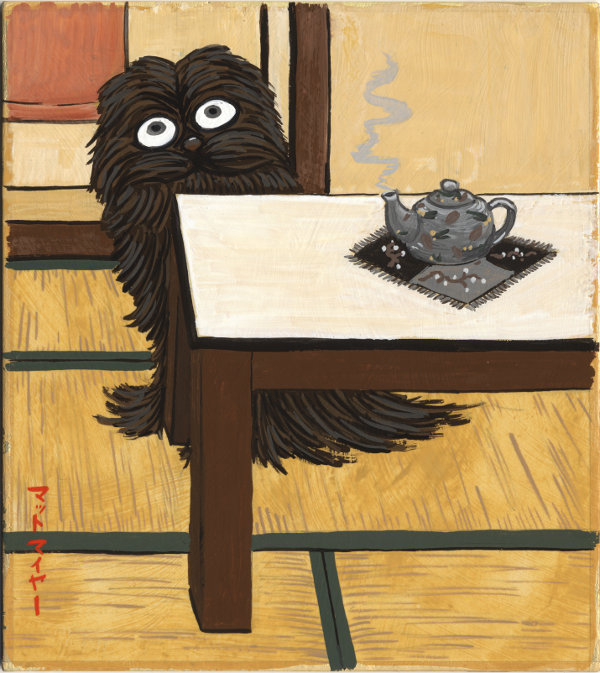A lot of people have asked me where I do my research on yokai for this project. I actually haven’t made any of these up — they existed for hundreds of years before I was even born. Most of my research is done on the internet, because the old yokai anthologies are all public domain now. However, there are also good references that can be found in libraries or on Amazon.com as well. The English Wikipedia has a lot of information on yokai — particularly in the form of scans of old yokai art books from hundreds of years ago located in the Wikimedia Commons. The Japanese Wikipedia has even more information, if you can navigate the Japanese. For those of you who want to learn more, here are a few good yokai chroniclers to reference:
- Shigeru Mizuki, author of the yokai manga GeGeGe no Kitaro
- Toriyama Sekien, ukiyo-e painter and author of The Illustrated Night Parade of A Hundred Demons (画図百鬼夜行, 1776), The Illustrated One Hundred Demons from the Present and the Past (今昔画図続百鬼, 1779), Supplement to The Hundred Demons from the Present and the Past (今昔百鬼拾遺, 1780), and The Illustrated Bag of One Hundred Random Demons (画図百鬼徒然袋, 1784)
- Tosa Mitsunobu, the 15th cenury painter of the original Hyakki Yakko Zu scroll
- Utagawa Yoshiiku, a 19th century painter
- Kawanabe Kyosai, one of my favorite yokai painters
- Sawaki Suushi, another one of my favorites, author of The Illustrated Volume of a Hundred Demons (百怪図巻, 1737)
Keukegen
Today’s yokai is a truly bizarre one, but even so it is a little bit cute… Its name is a pun with two different meanings — the first one being “fluffy-looking hairy thing” and the second being “unusual and rarely seen thing” — depending on the kanji used to write it. It kind of looks like a small dog covered in hair.
It lives in damp, dark places, and is actually a disease spirit. Despite its cuteness, if you find one of these in your house you are probably going to get very sick. Beyond that, there is very little documentation on this yokai. The earliest appearance of him is in Toriyama Sekien’s supplemental yokai anthologies, so I suspect it may be one that he invented just to fill in some pages. Not that that really cheapens it at all, of course.
If any yokai were to do well as a pet for humans, this would be it. In my opinion, it is just a like a small dog; tiny, hairy, and disease ridden. But then, I’m biased towards parrots myself.

Keukegen
Tomorrow I will update my Etsy store with additional yokai prints from the second week of October! | この「今日の妖怪シリーズ」のプロジェクトのために、私がいったいどうやってリサーチをしているのか?といったご質問を多くの方からいただきます。ご紹介している妖怪は私が創造したものではなく、全て100年以上前にあったものです。そのためほとんどの資料は大変古く、博物館などにあるためほとんどの情報はインターネットからとっています。しかしながら、図書館やAmazon.comで参考になる良い資料がみつかることもあります。Wikimedia Commons(ウィキメディア コモンズ)では、古い妖怪に関する画集を見ることができますし、日本のウィキペディアにはより多くの情報があります。妖怪についてもっと知りたい方のために、ここにいくつかご紹介します。
- Shigeru Mizuki: GeGeGe no Kitaro
- Toriyama Sekien: 画図百鬼夜行 (1776), 今昔画図続百鬼 (1779), 今昔百鬼拾遺 (1780), 画図百鬼徒然袋 (1784)
- Tosa Mitsunobu: Hyakki Yakko Zu
- Utagawa Yoshiiku
- Kawanabe Kyosai
- Sawaki Suushi: 百怪図巻 (1737)
それでは、今日の妖怪シリーズにまいりましょう。「今日の妖怪シリーズ」今日は毛羽毛現(けうけげん)です。毛羽毛現は本当に奇妙な妖怪ですが、ほんの少しかわいくもあります。毛羽毛現の漢字表記にはいくつかあり、「希有希見」や「希有希現」などで、いずれにしろ稀にしか見られないといった意味や羽のような毛といった意味があるようです。
毛羽毛現は湿っていて暗い場所に住み、病をもたらすものとされています。大変かわいらしい外見ですが、もしあなたがこの妖怪を家の中で見つけたならきっとひどい病気にかかってしまうでしょう。毛羽毛現に関しては、この言い伝えの他は情報が乏しいようです。
毛羽毛現を描いたものの中で最も古いものは鳥山石燕(とりやま せきいん)の妖怪画集にありますので、以前にもお話しましたが、もしかしたらこの毛羽毛現も石燕が創造した妖怪であるのかもしれません。もっとも、私はそれが悪いことだとは思わずむしろ楽しくて良い事だと考えています。
もし妖怪がペットとして人間にとって良いものであるならば、きっとこの子犬のような(小さくて毛深くて病気をもたらす)妖怪はうってつけでしょう。

毛羽毛現
My Etsy store でれまでの妖怪と英語版ですでに出ている妖怪達のプリント絵を買うことができます。チェックしてみてくださいね!

XD Omg! It’s a muppet!